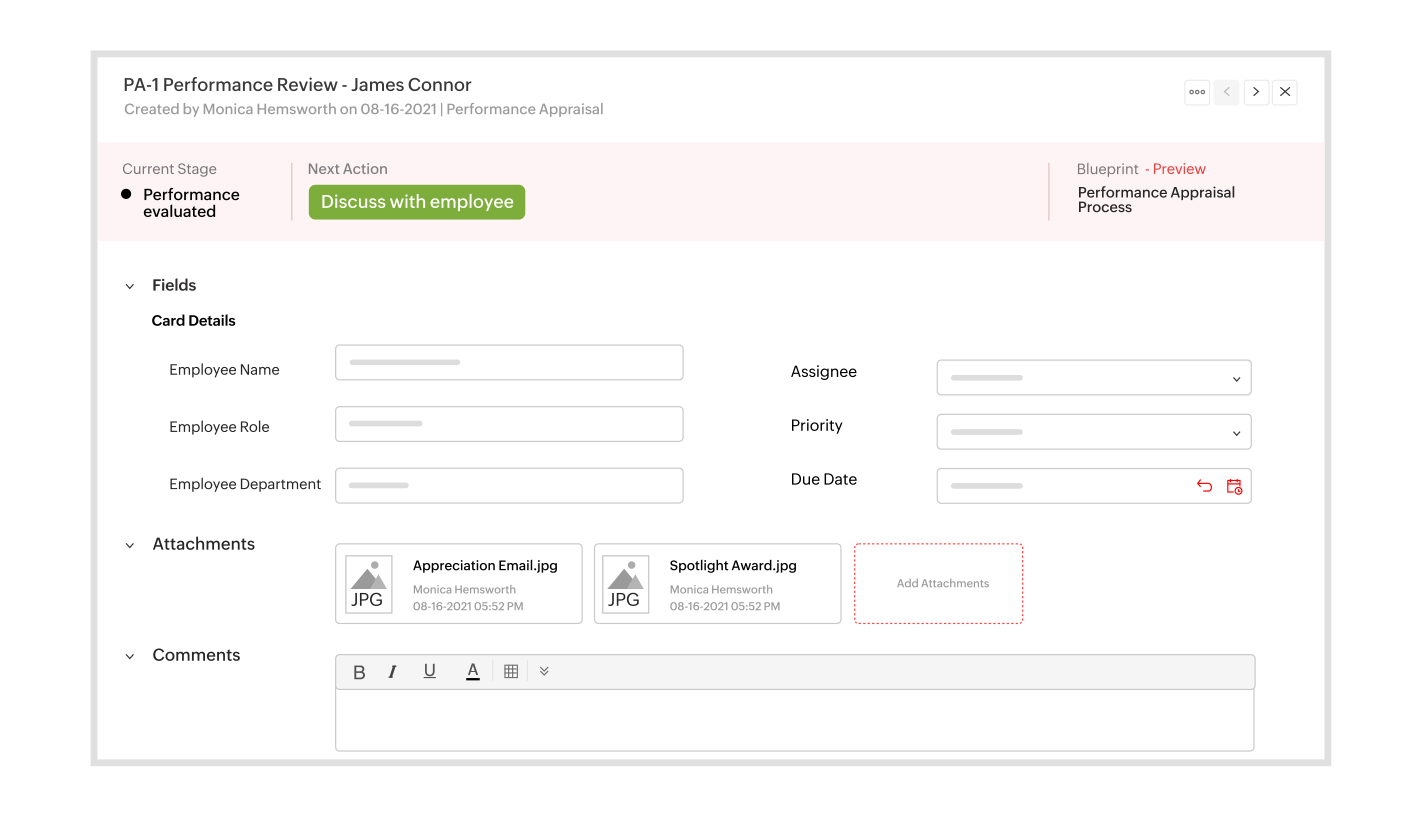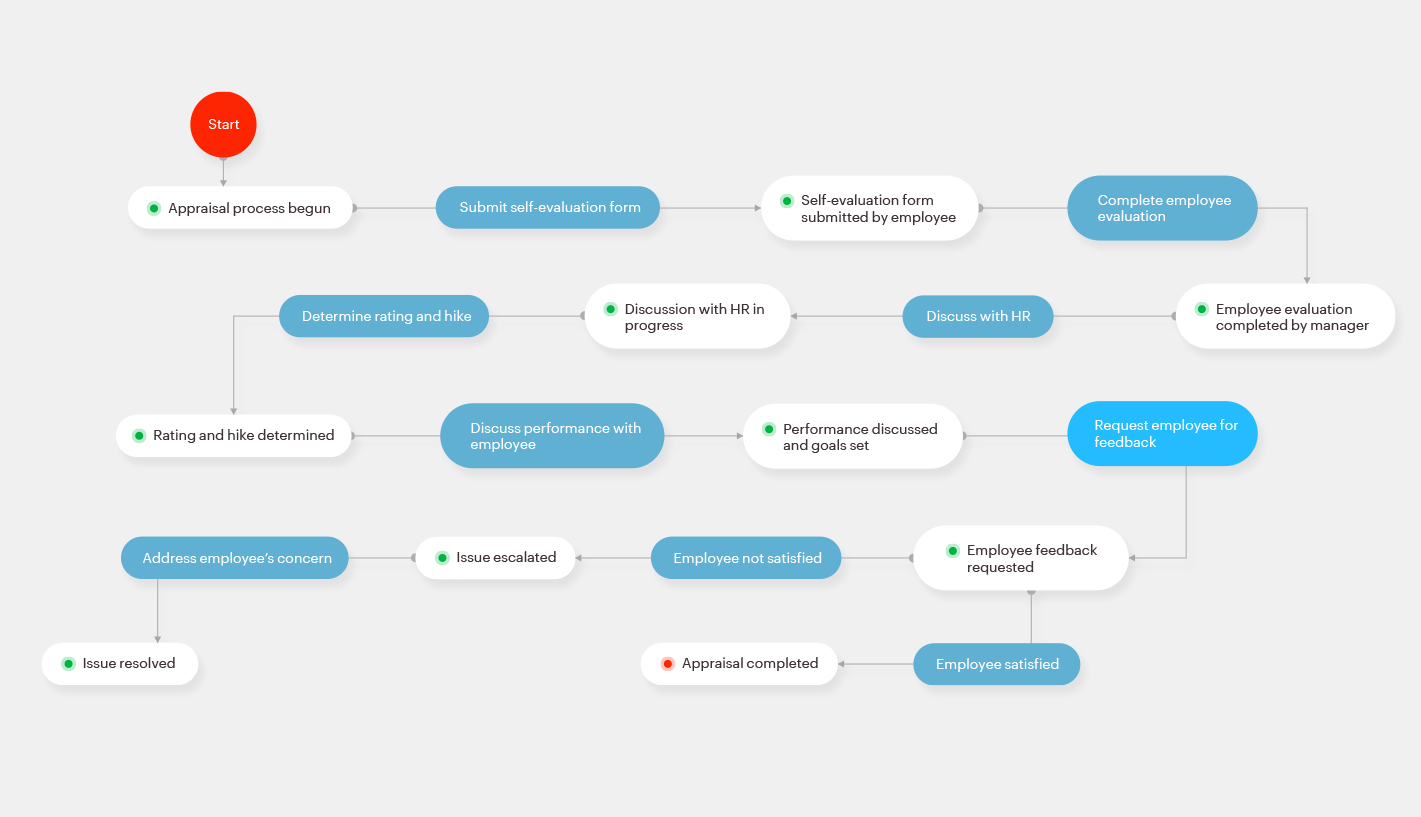Just because you have a performance appraisal process in place doesn't mean your entire workforce is going to blindly support it. Paper-based performance appraisals (or even flat-out verbal ones) do very little to motivate, empower, or inspire employees—and handing out annual or quarterly evaluation forms just isn’t doing the trick anymore.
You can run, but you can’t hide; performance appraisals are still just as important as ever. Lackluster performance management practices can cost you talent and have your remaining employees wondering if their evaluations are truly objective.
Every business wants to grow their talent while retaining their star employees. Your best shot at achieving this is tossing outdated performance management tools out the window and looking toward greener pastures.
Automating the performance management process comes with many perks.
Must-have features of a standout performance management workflow software:
Customizable workflow
You need the ability to create multiple performance review blueprints for different hierarchies, and the freedom to tailor the evaluation form to fit the work nature of respective departments. Tailoring a business-specific workflow shouldn’t take IT expertise or knowledge of coding. Organizations must be able to automate the appraisal process workflow without investing hours of their time.
Transparency
Employees will tell you again and again how concerned they are that bias will plant its roots in the appraisal process. The right appraisal tool provides total visibility, complete audit trails, and role-specific accessibility. Standardized processes remove grounds for favoritism, which boosts morale and improves employee satisfaction.
Goal tracking
Monitoring employee goal progress is a major pain point in performance management. The best performance appraisal tools will auto-collect data from all phases of the review cycle, store it, and analyze it for the best goal monitoring on both the manager and employee side. These things make it easier for managers to access employee records for promotion or transfer.
Easy Integration
Make sure the performance appraisal automation software you choose effortlessly integrates with existing human resource tools. You should be looking for rapid data exchange capabilities and little to no redundancy.
5 signs your business desperately needs a better performance appraisal system:
Lack of transparency between employees and management
Employees are often unsure about the fairness of their appraisals and question whether the quality of their work has any correlation with how other employees are measured, developed, or promoted. When an organization isn’t transparent, seeds of doubt begin to sprout. Everyone should understand the factors that influence their appraisal and have the opportunity to receive timely feedback on what they're doing well and areas in which they can improve.
A performance appraisal system makes evaluations easy for managers and fair for employees. The system should allow for collection, measuring, and managing of workforce performance data to nail down any performance gaps and identify top and subpar performers.
The performance management routine takes way too long
Is your team dragging out quarterly or annual performance reviews? It might be because the process is archaic. If paperwork, documentation, summarizing, creating reports, and getting approval is bogging your team organization down, it’s time to reevaluate your process and move to a centralized solution. After all, in the time it takes to endure old school appraisals, you could be discussing performance issues and professional development instead.
An effective performance appraisal system fast-tracks the whole performance management workflow and reduces paperwork. Automating the process of storing data within one system allows for seamless access and exchange of information. Timely alerts and notifications will alert responsible parties of deadlines, demonstrate progress on tasks, and eliminate miscommunication.
Team productivity and morale is low
Employee productivity is one of the ways business leaders evaluate success. When employee productivity is low, it’s likely due to loosely defined goals and no correlation between these goals and company objectives. If employees don’t see how their roles fit into company objectives, they might not think their jobs are being valued. That’s when hits on morale strike hardest, resulting in unengaged and unmotivated teams.
By making goals visible on a centralized dashboard, staff can track, review, and analyze their progress on objectives. This way, employees are productively using their skills to work toward professional development and directly impacting business goals.
Employee turnover is high
Turnover is an expensive problem for any company. It’s estimated that losing an employee can cost a company 1.5-2 times the employee’s salary. Yikes. Depending on the individual’s level of seniority, the financial burden can skyrocket. For the more technical positions, the cost increase is in the range of 100 to 150 percent of the original salary. C-suite turnover can cost a whopping 213 percent of salary.
Automating workflows and investing in an effective performance appraisal system can reduce turnover by prompting regular check-ins and keeping everyone on the same page. When companies don’t check in with their people often enough, they run the risk of losing them due to missed expectations, miscommunication, and feelings of isolation.
Performance metrics are non-existent
Collecting data for analysis is a big challenge when it comes to performance reviews. Most teams can’t instantly access powerful performance insights and comprehensive reports on their employees. A working performance appraisal system provides access to a variety of data about employee performance and development needs. Companies can use this data to analyze productivity, improve ratings, build career and development plans, and fill in performance gaps. HR teams benefit by running their workforce more effectively, and the business operations flourish as a result.
Immediate benefit of streamlining performance review workflows:
Time savings
Automate multiple time-consuming tasks, such as informing employees of their evaluation scores, collecting self-evaluation forms, reminding managers about deadlines, and sending updated salary information to payroll. Every employee's performance records are maintained and retrievable with just a few clicks.
Smoother administration
Standardizing and automating performance appraisal workflows helps simplify and speed up the administration process. With the ability to customize task assignees, performance review tasks, deadlines, and form fields, both HR pros and managers can seamlessly keep up with their checklists and track workflow tasks.
Improved professional development processes
With automated workflows for performance reviews, managers can spend time coaching employees and providing feedback, rather than getting bogged down by clunky, manual review processes.
Improved employee productivity
Employees can effortlessly capture and revisit their goals and manager feedback in a single place. Streamlining these workflows allows for much easier collaboration between employees, admins, managers, and other departments. When goal alignment is focused on execution of objectives, rather than the process of filling out objectives, productivity and morale skyrocket.
Ready to attract and retain the best of the best? Try Qntrl’s performance appraisal system on for size.








